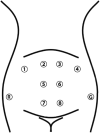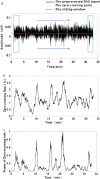Automatic recognition of uterine contractions with electrohysterogram signals based on the zero-crossing rate
- PMID: 33479344
- PMCID: PMC7820321
- DOI: 10.1038/s41598-021-81492-1
Automatic recognition of uterine contractions with electrohysterogram signals based on the zero-crossing rate
Abstract
Uterine contraction (UC) is an essential clinical indicator in the progress of labour and delivery. Electrohysterogram (EHG) signals recorded on the abdomen of pregnant women reflect the uterine electrical activity. This study proposes a novel algorithm for automatic recognition of UCs with EHG signals to improve the accuracy of detecting UCs. EHG signals by electrodes, the tension of the abdominal wall by tocodynamometry (TOCO) and maternal perception were recorded simultaneously in 54 pregnant women. The zero-crossing rate (ZCR) of the EHG signal and its power were calculated to modulate the raw EHG signal and highlight the EHG bursts. Then the envelope was extracted from the modulated EHG for UC recognition. Besides, UC was also detected by the conventional TOCO signal. Taking maternal perception as a reference, the UCs recognized by EHG and TOCO were evaluated with the sensitivity, positive predictive value (PPV), and UC parameters. The results show that the sensitivity and PPV are 87.8% and 93.18% for EHG, and 84.04% and 90.89% for TOCO. EHG detected a larger number of UCs than TOCO, which is closer to maternal perception. The duration and frequency of UC obtained from EHG and TOCO were not significantly different (p > 0.05). In conclusion, the proposed UC recognition algorithm has high accuracy and simple calculation which could be used for real-time analysis of EHG signals and long-term monitoring of UCs.
Conflict of interest statement
The authors declare no competing interests.
Figures







Similar articles
-
Automated electrohysterographic detection of uterine contractions for monitoring of pregnancy: feasibility and prospects.BMC Pregnancy Childbirth. 2018 May 8;18(1):136. doi: 10.1186/s12884-018-1778-1. BMC Pregnancy Childbirth. 2018. PMID: 29739438 Free PMC article.
-
Development of Electrohysterogram Recording System for Monitoring Uterine Contraction.J Healthc Eng. 2019 Jul 1;2019:4230157. doi: 10.1155/2019/4230157. eCollection 2019. J Healthc Eng. 2019. PMID: 31354930 Free PMC article.
-
Preliminary Study on the Efficient Electrohysterogram Segments for Recognizing Uterine Contractions with Convolutional Neural Networks.Biomed Res Int. 2019 Oct 13;2019:3168541. doi: 10.1155/2019/3168541. eCollection 2019. Biomed Res Int. 2019. PMID: 31737659 Free PMC article.
-
Accuracy of frequency-related parameters of the electrohysterogram for predicting preterm delivery: a review of the literature.Obstet Gynecol Surv. 2009 Aug;64(8):529-41. doi: 10.1097/OGX.0b013e3181a8c6b1. Obstet Gynecol Surv. 2009. PMID: 19624864 Review.
-
[Mechanical and electrical uterine activity. Part II. Contractions parameters].Ginekol Pol. 2008 Nov;79(11):798-804. Ginekol Pol. 2008. PMID: 19140505 Review. Polish.
Cited by
-
Enhancing uterine contraction detection through novel EHG signal processing: a pilot study leveraging the relationship between slow and fast wave components to improve signal quality and noise resilience.Front Physiol. 2025 May 27;16:1568919. doi: 10.3389/fphys.2025.1568919. eCollection 2025. Front Physiol. 2025. PMID: 40496244 Free PMC article.
-
Enhancing classification of preterm-term birth using continuous wavelet transform and entropy-based methods of electrohysterogram signals.Front Endocrinol (Lausanne). 2023 Jan 10;13:1035615. doi: 10.3389/fendo.2022.1035615. eCollection 2022. Front Endocrinol (Lausanne). 2023. PMID: 36704040 Free PMC article.
-
Assessment of Features between Multichannel Electrohysterogram for Differentiation of Labors.Sensors (Basel). 2022 Apr 27;22(9):3352. doi: 10.3390/s22093352. Sensors (Basel). 2022. PMID: 35591042 Free PMC article.
-
Characteristics of phase synchronization in electrohysterography and tocodynamometry for preterm birth prediction.Heliyon. 2024 Nov 15;10(22):e40433. doi: 10.1016/j.heliyon.2024.e40433. eCollection 2024 Nov 30. Heliyon. 2024. PMID: 39634434 Free PMC article.
References
Publication types
MeSH terms
Grants and funding
LinkOut - more resources
Full Text Sources
Other Literature Sources

